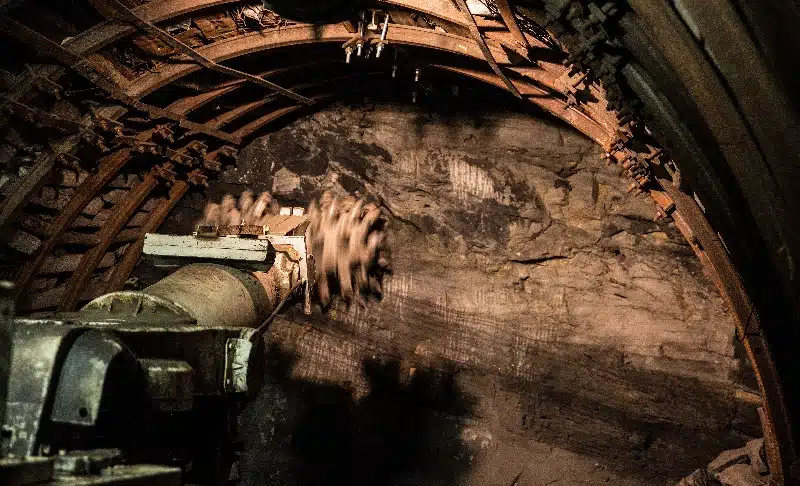Jusand Nominees Pty Ltd v Rattlejack Innovations Pty Ltd [2022] FCA 540
Date:
Court:
Judge:
16 May 2022
Federal Court of Australia
Rofe J
Background
Jusand Nominees Pty Ltd (Jusand) claimed that Rattlejack Innovations Pty Ltd and the other respondents (together Rattlejack) infringed three innovation patents relating to a safety system and method for protecting against a hazard of drill rod failure in underground mining by way of the sale of a product known as the SafetySpear.
Rattlejack sought revocation of the three patents for lack of sufficient description, lack of support, lack of clarity and lack of novelty in light of the patents’ own priority document (on the basis that the priority claim was not sound).
The invention of the patents is for use in underground mines. Material to be extracted (ore) is often accessed by excavating cavities into the rock strata below the ore and then drilling upwards towards the ore. The specification of the patents noted a significant problem in that the bores can be tens of metres long and during drilling it is not uncommon for the drill rod to break and become lodged in the bore. These heavy broken rod sections can unexpectedly become dislodged and fall down the bore potentially causing serious physical injury to mine workers and/or damaging mine equipment.
The invention of the patents comprises an anchor in the end region of the bore adjacent the rock-face and an impact reduction member within the bore above the anchor to absorb the force of a falling broken drill rod section.
Key Issues
The infringement case turned on the construction of three integers within the claims, being the “anchor member” and integers relating to its configuration. In particular, Rattlejack argued that the “anchor member” must be fixed and not move down the borehole more than a de minimus amount.
Another defendant, Murray, asserted the defence of experimental use under s119C of the Patents Act 1990 (Cth) (Act), on the basis that the relevant sale had been made for the purposes of a ‘field trial’.
Rattlejack’s argument in relation to enablement and support was that the claims of the Patents were not limited to a device made from any particular material, but no indication was given in the specification as to suitable materials for the anchor member other than steel.
Outcome
On infringement, Rofe J rejected the broader construction asserted by Jusand, finding (in line with the specification, expert evidence and dictionary meaning), that the skilled addressee would understand an “anchor member” to stop the movement of the safety system relative to the rock when impacted by a falling drill rod section. In particular her Honour noted references in the specification to movement of the impact reduction member, and considered in that context, silence as to any movement of the anchor member supported a construction that does not countenance movement of the anchor member beyond a de minimis amount. Her Honour further found that the claims required that the anchor member is configured to be fixed at the end of the bore, at or near the rock-face.
Jusand relied on the results of the defendants’ ‘drop tests’ to show that the SafetySpear had an anchor member that did not move when hit by falling drill rods. However there were a number of defects in the evidence of these tests – they had been conducted on a handmade SafetySpear prototype, not the commercial model, the observation of any movement could only be a ‘rough estimation’ and no leave was sought from the Court to rely on the experimental proof evidence. Furthermore, the instruction sheet for the SafetySpear indicated that it should be installed at least 1.5m into the bore hole. This was not at or near the rock-face. In the absence of any evidence that the integer of an ‘anchor member’ was present, or in the correct configuration, the infringement case failed.
On the issue of experimental use, Rofe J made the following general observations:
- The Explanatory Memorandum to the Raising the Bar Act which introduced the exemption in Australian law states that it should apply to tests, trials and procedures that a researcher or follow-on innovator undertakes as part of discovering new information or testing a principle or supposition. The reference to “trial” in the Explanatory Memorandum in this context must be to the kind of small scale trial undertaken in an experimental context. However it is apparent that “experimental” should be understood to have a broader application than just the limited context of work undertaken in laboratories.
- The different wording used in the secret use exception suggests that “experimental purposes” are to be distinguished from “for the purposes of reasonable trial”, as the latter, present in the secret use exception, has been intentionally excluded from the infringement exemption in s 119C of the Act.
- Section 119C gives guidance as to the nature of the acts which fall within the exemption: acts done for determining the properties of the invention, or for improving or modifying the invention, as well as acts done to determine patent claim scope, validity or infringement.
- The reference to “experimental purposes” connotes at least some application of scientific method to the discovering of new information or testing a principle or supposition, the testing of a hypothesis, the existence of a protocol or methodology
documentation of some kind setting out the purpose of the experiment and the variables to be measured or observed, the recording of results or observations, and the reporting of the results or observations.
Rofe J accepted that the limited drop tests of the SafetySpear, conducted with a limited number of prototypes to determine if they worked, fell within the experimental purposes exemption.
However the subsequent sale to Byrnecut for 12 month “testing” of 200 production model SafetySpears at its mines did not fall within the experimental use exemption. The successful drop tests had already established that the SafetySpear was as safe as or better than the existing grouting method of blocking bores containing broken drill bits. Furthermore, the agreement under which the products were supplied was entirely silent as to any experimental use or trial, and the express object of the Agreement was to identify and exploit sales. The SafetySpears were supplied at a commercial (not discounted) price that included a sales margin. Further, there was no scientific method associated with the trial and no documentation recording the details of the trial existed. No formal instructions about the trial were given to anyone at the relevant mines. Any “experimentation” involved nothing more than an ongoing monitoring program.
On the issue of enablement, Rofe J agreed with Rattlejack that the skilled person could not perform the invention across its full scope without undue experimentation and inventive skill or ingenuity, given the large range of possible materials and lack of any guidance as to their suitability in the specification. A similar conclusion was reached in relation to support since the technical contribution was limited to a device made from steel. The clarity objection was not upheld.
Implications
This decision is the first decision on s119C and provides some guidance on this defence, although in this case the alleged experimental use was found to have occurred in the context of a commercial sale, rather than experimentation internally with a commercial purpose. The contours of this defence will therefore require further clarification including whether documentation evidencing a protocol or methodology of experimentation will suffice to establish the defence.
Her Honour’s conclusions on enablement and support are a further example of the reach of these grounds of invalidity for patents governed by the Raising the Bar law and emphasise the need for care in drafting patents for mechanical inventions to address possible materials, if the claims are not limited in that regard.
Jusand filed an appeal from Rofe J’s decision in June 2022, which was heard in November 2022.
About Pearce IP
Pearce IP is a boutique firm offering intellectual property specialist lawyers, patent attorneys and trade mark attorneys to the pharmaceutical, biopharmaceutical and life sciences industries. Pearce IP is the 2021 ‘Intellectual Property Team of the Year’ (Lawyers Weekly Australian Law Awards) and was shortlisted for the same award in 2022. Pearce IP is ranked in IAM Patent 1000 and Managing IP (MIP) IP Stars, in Australasian Lawyer 5 Star Awards as a ‘5 Star’ firm, and the Legal 500 APAC Guide for Intellectual Property. Pearce IP leaders are well recognised as leading IP practitioners.
Our leaders have been recognised in virtually every notable IP listing for their legal, patent and trade mark excellence including: IAM Patent 1000, IAM Strategy 300, MIP IP Stars, Doyles Guide, WIPR Leaders, 5 Star IP Lawyers, Women in Law Awards – Partner of the Year, Best Lawyers and Australasian Lawyer 5 Star Awards, Women in Business Law Awards – Patent Lawyer of the Year (Asia Pacific), Most Influential Lawyers (Changemaker), among other awards.

Naomi Pearce
CEO, Executive Lawyer (AU, NZ), Patent Attorney (AU, NZ) & Trade Mark Attorney (AU)
Naomi is the founder of Pearce IP, and is one of Australia’s leading IP practitioners. Naomi is a market leading, strategic, commercially astute, patent lawyer, patent attorney and trade mark attorney, with over 25 years’ experience, and a background in molecular biology/biochemistry. Ranked in virtually every notable legal directory, highly regarded by peers and clients, with a background in molecular biology, Naomi is renown for her successful and elegant IP/legal strategies.
Among other awards, Naomi is ranked in Chambers, IAM Patent 1000, IAM Strategy 300, is a MIP “Patent Star”, and is recognised as a WIPR Leader for patents and trade marks. Naomi is the 2023 Lawyers Weekly “IP Partner of the Year”, the 2022 Lexology client choice award recipient for Life Sciences, the 2022 Asia Pacific Women in Business Law “Patent Lawyer of the Year” and the 2021 Lawyers Weekly Women in Law SME “Partner of the Year”. Naomi is the founder of Pearce IP, which commenced in 2017 and won 2021 “IP Team of the Year” at the Australian Law Awards.

Kate Legge
Special Counsel, Lawyer
Kate is an experienced IP and patent lawyer, providing IP leadership for pharmaceutical product development and commercialisation in global markets – from initial scoping through to post-launch.
She has developed and implemented global IP strategies over more than 15 years at multi-national pharmaceutical companies. She is an Australian qualified and registered legal practitioner, and has a Master’s degree in IP Law and a BSc in biochemistry.

